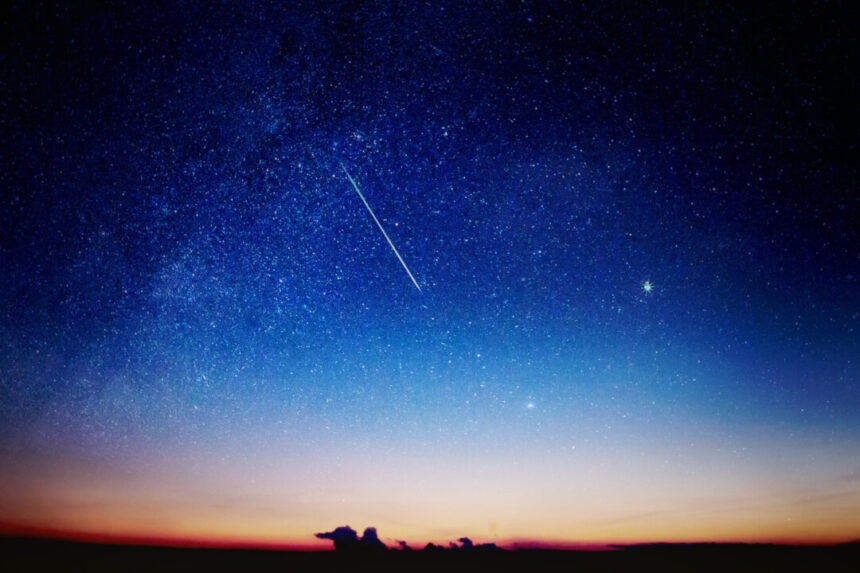One night in 1983, two astronomers using the world’s first space telescope spotted a strange hunk of space rock that looked like a star. It was almost five kilometres wide and calculated to be a “potentially hazardous” near-Earth object whose orbit around the sun grazes by our planet every 50 years.
The good news is that the Geminids are famed for their bright shots of light; you still could spot 50 meteors per hour.
How to Spot the Geminids
The Geminids are mainly a Northern Hemisphere event. Meteors seem to radiate from a single point in the sky, called the radiant. The Geminids’ radiant aligns almost perfectly with bright star Castor in the northerly Gemini constellation. Gemini gave rise to the name “Geminids.”
The Geminids’ alignment with Castor is merely optical, however—the meteors don’t actually hail from anywhere near that star. Castor is 52 light-years away, while meteors burn up only about 100 kilometres above Earth’s surface. To the terrestrial observer, meteors seem to converge at the radiant because they travel parallel through space. It’s like how train tracks appear to converge on the horizon—just a trick of perspective, nothing more.

A meteor from the Geminids meteor shower enters the Earth’s atmosphere past the stars Castor and Pollux on Dec. 12, 2009. Stan Honda/AFP via Getty Images
Over the next few weeks, those who are paying close attention may spot shots of light anywhere except the radiant. It sounds counterintuitive, but astronomers advise to not look to the radiant for meteors, as they’ll shoot straight toward you and be almost invisible. Meteors are best viewed as they fan out from the radiant. The Geminids are known to graze the atmosphere nearly horizontally.
Meteor viewing is optimal at 2 a.m. (in all time zones) when the radiant culminates to its height and the most bountiful area of sky will present itself. If you’re someone who makes a wish when seeing a shooting star, this is the ideal time to relax in a lawn chair, sip on hot cocoa, and savour the winter beauty while making a wish.
The shining gibbous moon that turns full on Dec. 15, however, will present stiff competition for the Geminids. Astronomers advise seeking a vantage point where the moon is blocked from view. Besides moonlight, Canadian stargazers may also catch a curtain of auroras dancing along.
The Geminids’ Mysterious Parent Object
As for that strange space object discovered in the 1980s and credited for spawning the Geminids, it was studied and proved a mystery indeed. After analysis, it was named 3200 Phaethon, drawing from Greek mythology, and classified an asteroid. But this was no ordinary asteroid.
Asteroids are basically just space rocks. There were few worries that this “potentially hazardous” rock would collide with Earth—astronomers knew it wouldn’t for the next 400 years. But what drew attention to 3200 Phaethon was its path: Somehow its elliptical orbit matched the Geminids’ to a tee. Never before had an asteroid been associated with meteors.
Since asteroids are just hunks of rock, scientists wondered how they could possibly cause meteors. They knew meteors weren’t born from asteroids but from stellar objects called comets. Described as “dirty snowballs” in space, comets sublimate (turn from a frozen to gaseous state) when they get near the sun. They sometimes display an eerie greenish glow, called a coma, and a tail.
In an agitated state caused by solar radiation, a comet sheds material and distributes vast complexes of debris that follow its orbit. As Earth orbits, it can plough through that dust stream. Bits of cosmic debris hit Earth’s atmosphere and burn up, turn into meteors, and put on a show.

A radar image of near-Earth object 3200 Phaethon was generated by astronomers at the National Science Foundation’s Arecibo Observatory on Dec. 17, 2017. Public Domain/Arecibo Observatory/NASA/NSF
Astronomers theorized how a rock in space could do this. Two theories emerged: Could 3200 Phaethon be an extinct comet that had shed all its volatile material and left behind a rocky nucleus, or was this a dormant comet with unstable material still trapped inside? It must be one or the other, they concluded. But one thing was clear: This asteroid had somehow made the famed meteor shower known as the Geminids.
Then on Dec. 17, 2017, astronomers at the Arecibo Observatory in Puerto Rico captured images of 3200 Phaethon at its closest point to Earth. Radar images showed the grainy yet unmistakable grey blob partly cast in shadow. A similar “close” encounter won’t occur again until 2093 when the asteroid returns to Earth.
It says something about mankind that we are now set to launch a spacecraft to intercept 3200 Phaethon in 2025.
Originally scheduled for 2024, the launch date of the mission to visit the asteroid was postponed by Japan’s space agency, JAXA, until after the New Year. However, we, as humans, were not content to simply wait for its return or host its emissaries, the Geminids. Instead, we have chosen to boldly venture out into space and explore the asteroid on its home turf.
Source link





